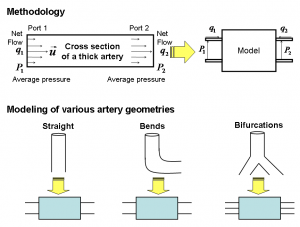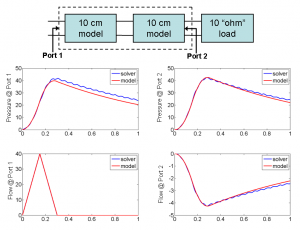Modeling and Simulation of Blood Flow in Arterial Networks
- Category: Medical Electronics
- Tags: healthcare, luca daniel, yu-chung hsiao
Understanding certain medical conditions requires understanding specific aspects of the arterial blood flow. For instance, diagnosing atherosclerosis requires capturing detailed flow inside an arterial segment. Such study requires developing accurate solvers for the detailed equations describing both the blood flow and the elastic behavior of the arteries. At the other end of the spectrum, studying hypertension requires computing pressure and averaged flow over a larger arterial network. Such analysis requires developing compact computationally inexpensive models of complex segments of the arterial network. These models relate the pressure and average flow at the terminals of the arterial segments and must be easily interconnected to form complex and large arterial networks.
In this project we are developing a 2-D fluid-structure interaction solver to accurately simulate blood flow in arteries with bends and bifurcations. Such blood flow is mathematically modeled using the incompressible Navier-Stokes equations. The arterial wall is modeled using a linear elasticity model [1] . Our solver is based on an enhanced immersed boundary method (IBM) [2] . As a second step we are developing system identification techniques [3] to generate passive models for complex arterial segments such as large arteries, arterial bends, and bifurcations. We have validated our solver results versus reference results obtained from MERCK Research Laboratories for a straight vessel of length 10 cm and diameter 2 cm. Our results for pressure, flow, and radius variations are within 3% of those obtained from MERCK. Furthermore, we are validating our model results by cascading different models and comparing the results of the resulting network to those predicted by our solver. Our preliminary results for pressure and flow at the terminals of the models are within 10% of those obtained from the full simulator. In addition, with our models we reduce the computational time by more than 100,000 times.
- Figure 1: We use i) our immersed boundary method for incompressible Navier-Stokes to extract a complete model ii) our system identification technique to construct a reduced model [3] . The lower part shows three major artery geometries we use for modeling a cardiovascular system.
- Figure 2: A 20-cm artery is constructed by cascading two 10-cm artery models terminated with a matched load. The transient simulation results of the cascaded model are compared with those of a 20-cm artery solved by our immersed boundary method solver.
- A. Quarteroni, M. Tuveri, and A. Veneziani “Computational vascular fluid dynamics: problems, models and methods,” Computing and Visualization in Science, vol. 2, no. 4, pp. 163-97, 2000. [↩]
- C. Peskin and D. McQueen “A three-dimensional computational method for blood flow in the heart I. Immersed elastic fibers in a viscous incompressible fluid.” Journal of Computational Physics, vol. 81, issue 2, pp. 372-405, 1989. [↩]
- B. Bond, T. Moselhy, and L. Daniel, “System identification techniques for modeling of the human arterial system,” in Proc. SIAM Conference on the Life Sciences, Pittsburgh, PA, July 2010, p. 12-15. (invited) [↩] [↩]

